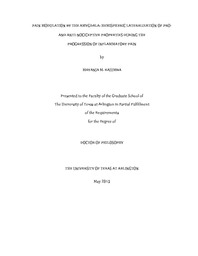| dc.description.abstract | Inflammatory pain is a feature of various diseases, and a leading cause of disabling discomfort among patients. Despite the extensive and costly neurophysiological and pharmacological research, even the most potent of the currently available treatments do not work for all patients, and cause adverse side effects that hinder effective pain management. In an attempt to identify potential target sites for alternative pain alleviation procedures, the current study investigated the role of the central nucleus of the amygdala (CeA) in the onset and progression of inflammatory pain. Both the left and right CeA receive, and are activated by nociceptive input, but the changes in synaptic plasticity and sensitization have been found to be lateralized in the right CeA. This is the first in vivo study to investigate the pain-related changes in the CeA neural oscillations, as a basis for demonstrating lateralization of pro- and anti-nociceptive properties. The main goal of this study was to determine the changes in the left and right CeA activity as the pain progresses, and effect of unilateral lesion of the CeA on the onset and progression of inflammatory pain. The study comprised of adult Sprague Dowley rats with: 1) right CeA lesion, 2) left CeA lesion, and 3) non-lesion (control) group. Rats in each of the lesion groups had a bipolar electrode implanted into the spared left or right CeA. The non-lesion group had two subgroups of rats with either right or left CeA electrode implant. Inflammatory pain was induced by subcutaneous injection of 2 mg of carrageenan (100µl of 2% (w/v) in saline) into either the left or right hind paw. Local field potential (LFP) oscillations were recorded at 6 time points; that is, baseline, immediately, 1, 3, 5, and 48 -72 hours after the carrageenan injection. The paw withdrawal thresholds and latencies, as well as the LFPs induced by thermal and mechanical stimuli were recorded at all the time points, except immediately after the injection. Overall, the results revealed: 1) lateralized increase and decrease in the CeA oscillatory activity in some, but not all, frequency bands and conditions; 2) the right and left CeA oscillations were respectively affected by inflammation in bilateral and unilateral receptive fields; 3) the patterns of lateralized increase in right CeA delta and decrease in left CeA beta oscillations were consistent with the known trend of pain-related changes in the synaptic plasticity and sensitization of CeA neurons; 4) the right, but not the left, CeA lesions induced early onset and enhanced thermal and mechanical sensitivity; and 5) with some similarities and differences, both the right and left CeA neural oscillations were strongly correlated with, and significantly predicted peripheral mechanical and thermal sensitivity. This is the first in vivo study to demonstrate the pain-related functional significance of the right and left CeA neural oscillations, and provides numerous implications, and insight into directions for future research. | en_US |

